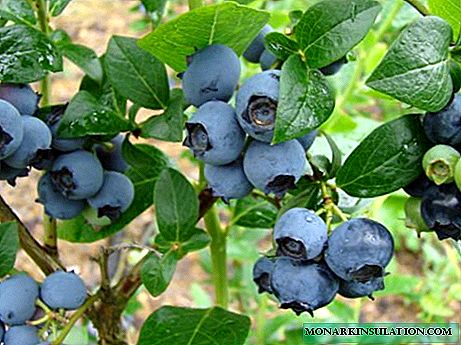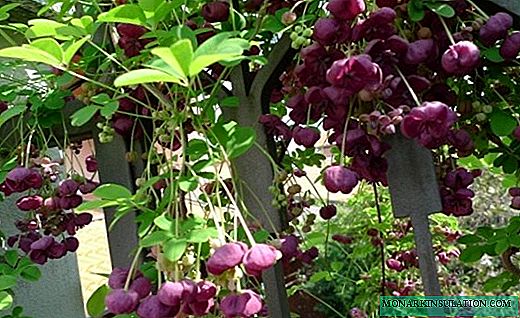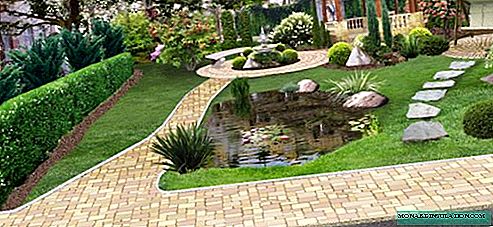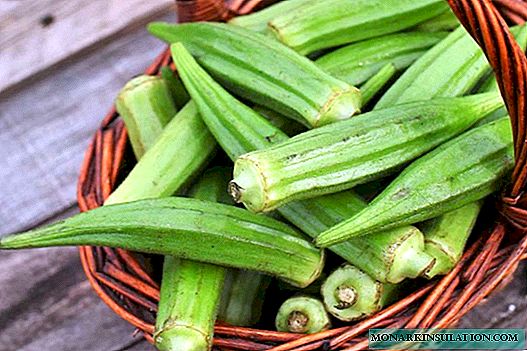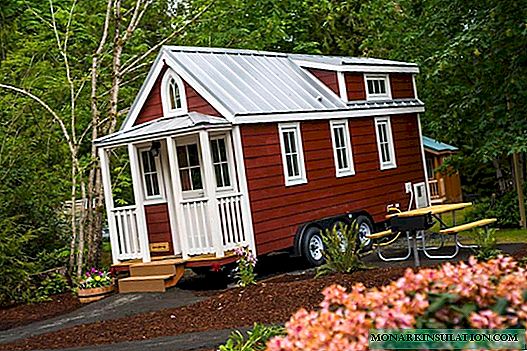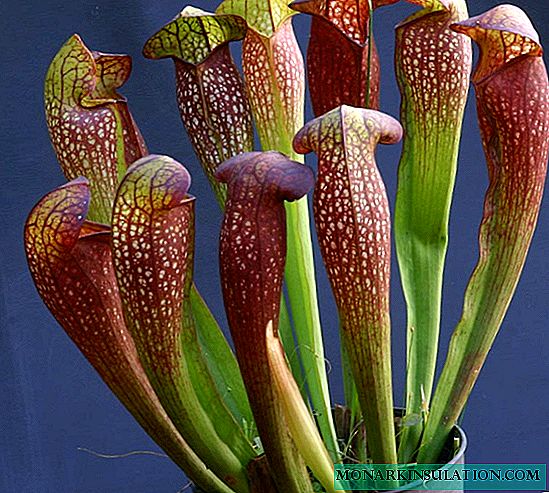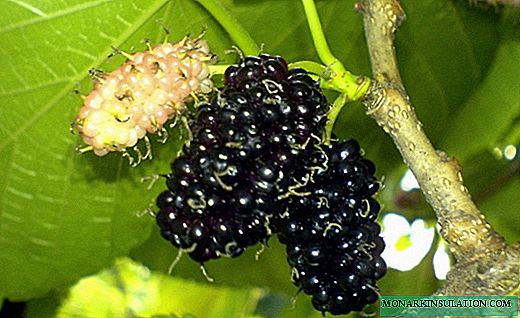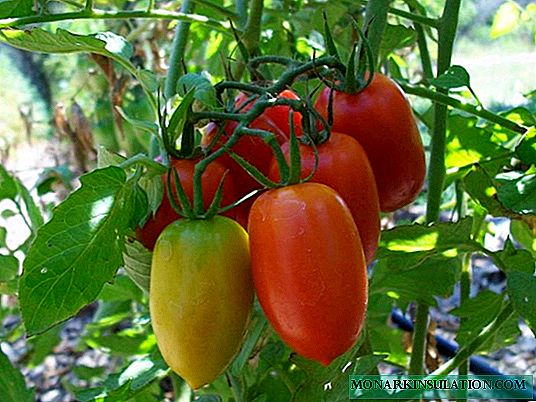
Early vegetables and fruits are not always the most delicious, but they are the most coveted. When the body misses this or that natural product, it does not perceive the subtleties, not in the early summer to gastronomic delights. But often the early varieties of vegetables are quite good in taste. Among the tomatoes, one of these varieties is the Shuttle, abundantly bearing beautiful red fruits.
Description of shuttle tomato: characteristics and regions of cultivation
The shuttle tomato variety of early ripening was included in the State Register of Breeding Achievements of the Russian Federation in 1997. Officially, it is recommended for cultivation in the open ground. Three regions were proposed for its cultivation: Central, Volga-Vyatka and West Siberian. However, it is planted in greenhouses, and not only in these regions. Gardeners are well aware of gardeners not only in Russia, but also in neighboring countries, for example, Ukraine, Belarus and Moldova.
Shuttle is a variety of domestic selection: it was bred at the All-Russian Research Institute of Seed Production and Selection of Vegetable Crops. The state registry assumes its use in home gardens and other small farms. This is an early ripe tomato, the ripening of its fruits occurs 82-121 days after emergence, that is, in the middle band, the first tomatoes ripen at the very end of June, after which fruiting continues until frosts.
The Shuttle bush is very compact, upright, only 40-45 cm high, the branching is weak, the leafyness is average. This fact makes the variety desirable for those summer residents who have miniature plots; some enthusiasts grow it even on the balcony. The leaves are dark green in color, medium in size, glossy. The inflorescences are simple: the first of them appears above the 6th or 7th leaf, and then every 1 or 2 leaves.

The bushes do not require tying, but if the harvest is large, many gardeners still support him.
Shuttle is a non-capricious variety. It is undemanding in care, gives good yields even in rainy and cool seasons, it is one of the relatively few truly Siberian varieties. However, his susceptibility to diseases, including late blight, is at his average level. Due to the very dense stem (and the Shuttle is a standard plant), it dispenses with garters for supports, even rich crops do not overwhelm the bushes.
The Shuttle variety is considered to be superdeterminant: it does not require formation and pinching, and due to its compactness and stability in space, the fruits are evenly warmed up in the sun. Since the bushes take up little space, they are often planted: every 35-40 cm. The variety is so cold-resistant that it can be grown in unprotected soil, even in the northern regions. However, many gardeners who want to grow very early crops, plant shuttles in greenhouses.
The fruits of this tomato are arranged in clusters on the bushes. The total yield is average, but very good for an early variety: the usual numbers are 4-5 kg / m2record - 8 kg / m2. Fruit ripening is gradual.
The shape of the fruit is interesting, it is not so common, so the Shuttle is easy to recognize among other varieties of tomatoes. They are elongated-oval, with a nose on top, sometimes they say "pepper-like." There is no ribbing, the color of the ripe fruit is bright red, of the seed chambers 2 or 3. Tomatoes are medium-sized, weighing 25-55 g, therefore they can be used not only in fresh form, but also for whole-canning.
Fruits weighing up to 150 g are described, but to obtain them, rationing of the crop is necessary.
The pulp is fleshy, sweet. The taste, both fresh and pickled, is considered good, and the chemical composition allows the Shuttle to be used in baby food. The crop is well transported and stored for a rather long time: for several days without a refrigerator, external changes and spoilage of taste are not noted.
Appearance of Tomatoes
Those who know what most varieties of bell pepper look like can easily explain the shape of the shuttle tomato. They also say that the shape of the fruit resembles a real shuttle. But how many modern gardeners saw him?

Drops of fruit are convenient for cutting into rings
On the bushes, you can simultaneously see the fruits of different degrees of ripening and even of different sizes, since the fruiting of the Shuttle is very stretched in time.

The fruiting of the Shuttle is stretched, so you can see different colored tomatoes on the bushes at the same time
Advantages and disadvantages of the variety
There is nothing ideal, and when we read only enthusiastic reviews about something, the thought creeps in that this is not entirely true. Of course, the Shuttle tomato has flaws, including very significant ones. But undoubtedly, he has more obvious advantages. This is for example:
- cold resistance of the variety: of course, the bushes will die in frost, but the plant can withstand very low positive temperatures, like their sharp drops, easily;
- lack of need for forming and even tying up the bush: all work in this regard is limited to the removal of lower leaves as the fruits grow;
- good, for an early grade, productivity;
- very good taste of early ripening tomatoes;
- convenient size of fruits, allowing you to use them for canning in standard banks;
- universal purpose of the crop, its good transportability and preservation in fresh form;
- extension of fruiting: starting to ripen in June, the crop continues to arrive until frost.
Among the minuses of the variety are most often noted:
- low resistance to disease;
- decrease in yield in case of cooling during mass flowering;
- excessive acidity of the fruit;
- Significant reduction in flavor during canning.
The positive aspects, undoubtedly, outweigh the negative ones, therefore the Shuttle enjoys well-deserved and undeniable popularity among amateur gardeners of most of our country. The main difference from most other early ripe tomatoes, of course, is in the form of fruits: not many varieties have a pepper-like shape. It is hardly possible to consider this an advantage, but there are many lovers of such tomatoes: they are very convenient to cut into rings, for example, for sandwiches. Such fruits look beautiful on festive tables. De Barao's tomato form is somewhat similar, but this variety does not belong to the early ones.

De Barao's fruit does look a bit like Dropship, but it's a mid-season variety growing in a tall bush.
If we distract from the form, then among the early ripe tomatoes, Shuttle is one of the best, successfully competing, for example, with White Bulk or Betta. All of these varieties have comparable yields, resistance to diseases, and the taste of fruits: if, for example, the White filling wins a little in unpretentiousness, then the Shuttle in elegance, and Betta in precocity. Actually, there are many hundreds of varieties and hybrids of tomatoes, and each gardener chooses his own favorites for himself.
Features of agricultural technology
Tomato Shuttle is very unpretentious, therefore, it is difficult to note significant features in its agricultural technology compared to most similar varieties of tomatoes. Like all tomatoes, it is grown mainly through seedlings. Direct sowing in the garden is possible only in the southern regions, such as the Krasnodar Territory or Astrakhan Region.
Planting Tomatoes Shuttle
If we talk about most of the territory of our country, concerns about seedlings of tomato shuttle begin in March. There are lovers sowing seeds in pots already in February, but this is justified only if the apartment has the possibility of good lighting seedlings, and growing tomatoes is supposed to be in the greenhouse. Indeed, from sowing seeds to seedlings at home to planting it in the garden takes about two months. This is exactly what should be borne in mind when calculating the timing of sowing seeds.
When planting seedlings in the bed, the soil temperature should not be lower than 14 aboutC, and the air temperature should not fall significantly below such values. For example, in the conditions of the Moscow Region, landing in the ground without shelter is possible only at the end of May, and in the regions and territories of Siberia only at the beginning of summer. Therefore, the beginning of the hassle of growing seedlings falls mainly in the second half of March: for example, in the Central Black Earth region around the 15th, in the northern regions - in the very last days of the month.
The process of preparing seedlings includes the following steps.
- Seed preparation (this can be calibration, disinfection, hardening, germination). The gardener decides whether to carry out all the actions himself: good seeds can be sown and dry, and of dubious quality - it is better to carry out through all the above operations. The seeds are calibrated by shaking in a 3% solution of sodium chloride, after which not drowned are discarded. Disinfect with a 20-30-minute bath in a dark solution of potassium permanganate. Tempered by keeping in a wet cloth for 2-3 days in a refrigerator. Germinate in the same cloth until the appearance of miniature roots.

Germination is completed when a few millimeters long tails appear
- Soil preparation. Its optimal composition is peat, humus and good turf land taken equally. A handful of wood ash is added to the bucket of the mixture, after which the soil is disinfected by pouring a pink solution of potassium permanganate. You can buy a ready-made soil mixture, you don’t need to do anything else with it.

When buying soil in a store, it is advisable to choose the one that says about tomatoes
- Sowing seeds in a box. You can, of course, and immediately in personal cups, but it is better to first in a small box or box, and then planted. The height of the soil is at least 5 cm, the prepared (or even dry) seeds are laid out in grooves shed by water to a depth of about 1.5 cm, maintaining a distance of about 2.5 cm between them.
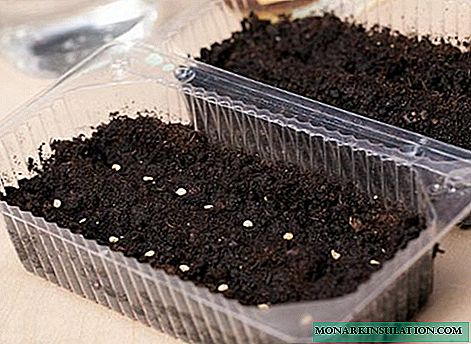
Any convenient box is suitable for sowing seeds.
- Withstanding temperature conditions. After 4-8 days (depending on preparation and temperature), shoots should appear in a glass-covered box, after which the temperature is immediately reduced to 16-18 ° C, and the illumination is given the maximum possible (the southern window sill is normal in March). After a few days, the temperature was raised to room temperature.
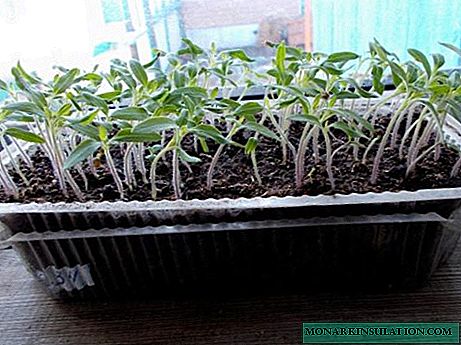
It is very important that the seedlings are well lit from the very first hour
- Pick-up: carried out in stage 1-3 of these leaflets. Tomatoes are planted in separate cups or in a larger box; in the latter case, the distance between the plants is about 7 cm.

The best option is to provide each plant with a peat pot
Seedling care consists in moderate watering and, possibly, 1-2 feeding with a weak solution of any complex fertilizer (according to the instructions for it). However, if the growth is normal, you should not fertilize once again: fattening seedlings are no better than those grown in ascetic conditions. Over 10-15 days of planting in the garden, seedlings are periodically taken out to fresh air, accustoming the plants to the breeze and low temperatures.
It is not necessary to expect that the bushes will grow tall: at the Shuttle, if everything is fine, the seedlings grow compact, strong, rarely exceeding a height of 20-22 cm by two months. It is important that there is a thick stem and bright leaves; well, if at the time of transplantation in the garden a few buds have formed.
Planting seedlings in the garden is carried out with the onset of really warm weather. And if they planted in unprotected soil in the middle strip of Shuttle at the very end of May, then in an ordinary greenhouse - 2-3 weeks earlier. In the heated - as seedlings are ready. It is important that both air and soil are warmed up.
An open area for tomatoes is chosen so that it is closed from the effects of cold winds and well lit. If possible, the garden bed is prepared in the fall, bringing in it the usual doses of organic and mineral fertilizers. Tomatoes are especially needed for phosphorus, so reasonable doses are a humus bucket, a handful of wood ash and about 40 g of superphosphate per 1 m2.
In the same way, a garden bed is prepared in a greenhouse. True, the Shuttle can hardly be called a greenhouse tomato. Planting it in a greenhouse is unprofitable: greenhouse varieties are usually high, occupying, if possible, the entire volume provided, and there will be no space above Shuttle. But some gardeners who love the variety plant a small amount of bushes in the greenhouse to please themselves with a very early harvest.
The shuttle is planted relatively densely: 40 cm between the bushes is already a luxury. The usual landing technique:
- Dig a small hole with a scoop in selected places, add a little local fertilizer to each hole. It can be half a glass of ash or a dessert spoon of nitroammofoski. Fertilizers are mixed with the earth, after which the hole is watered.
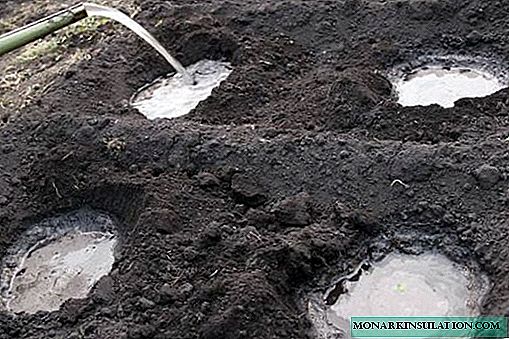
The most reliable way to put "in the mud", so the holes are pre-watered
- Carefully remove the seedlings from a box or cups with a lump of earth and place it in the holes, deepening to approximately cotyledon leaves. Since the Shuttle usually does not outgrow during the preparation of seedlings, it does not need to be planted obliquely.

The more whole the earthen lump will be, the sooner the seedlings will take root
- Pour tomatoes with water at a temperature of 25-30 aboutC and mulch the soil around the bushes a little.

When watering, you can use a watering can, but in the heat it is better not to get on the leaves
Of course, it’s good if all this is done in cloudy weather or at least in the evening.
Tomato Care
Caring for a tomato Shuttle is simple. It includes watering, loosening the soil, weed control and periodic top dressing. The best time for watering is evening, the frequency in normal weather is once a week. Water should be warm, warmed up per day in the sun. Hosing tap water is not recommended. If the surface layer of the earth seems moist, watering should be postponed: tomatoes do not need excess water. The greatest need for water is in the first time after mass flowering. But as the fruit stains, watering significantly reduces, or even excludes.
After each watering or heavy rain, the soil around the plants is loosely cultivated with the simultaneous destruction of weeds. Fertilizing is given infrequently, 3-4 times a season, using complete mineral fertilizers. The first time the Shuttle is fed with the advent of the first small ovaries, the size of a cherry. After watering, scatter 1 m2 about 20 g of azofoska or a similar preparation, after which they are watered again. You can also dissolve the fertilizer in water, and then make it from a watering can.
Repeated feeding - every two or three weeks. Instead of azofoska, you can also use natural fertilizers - a mixture of mullein and wood ash infusion, but it is always advisable to add superphosphate for tomatoes.

Recently, superphosphate is often enriched with nitrogen: this is a good option
The variety does not require tying and pinching, which facilitates the care of even an inexperienced summer resident. Only occasionally experienced gardeners cut off part of the flowers, leaving no more than 4-5 pieces in the brush to get relatively large fruits. This operation does not affect the total yield from the bush.
In private areas, they rarely engage in preventive spraying of tomatoes from diseases. But we must remember that the Shuttle is not very resistant against late blight, which can overtake it with significant cooling in the second half of summer. In greenhouses, constant ventilation is necessary: in stagnant, humid air, outbreaks of a whole complex of diseases are possible. And yet, in the case of not very favorable weather, it is advisable to spray at least with folk remedies (such as infusion of onion scales).
If the disease is attacked, use chemicals with extreme caution, without neglecting a thorough study of the instructions.Of them, if possible, it is worth choosing the most non-toxic, such as Ridomil or Fitosporin, especially if there is not enough time left before harvesting.
Video: caring for determinant tomato varieties
Grade Reviews
The shuttle turned out to be an excellent unpretentious productive early variety, grew on a bush in the exhaust gas and the greenhouse, did not stepchild. Pretty tasty fresh, and mainly for jars. Ripen from July 10 when sowing in early March. A local gardener shared his seeds, in which he ripens in an unheated greenhouse by mid-June. He sows at the end of February and stepson for such an early harvest.
Svetik
//www.tomat-pomidor.com/newforum/index.php?topic=4466.0
I plant the Shuttle in the ground. Blushes first, early. But for the greenhouse it is not very, because low, does not use space and quickly ends bearing fruit.
Freken 10
//dacha.wcb.ru/index.php?showtopic=54336
I had about 70 centimeters bush, I still tied it to a stick so that it wouldn’t wallow, it wouldn’t pinch, but I think it’s a bit possible, otherwise it turns out to be too big. Tomatoes are good, beautiful cream, fruitful, peel firm, moderately fleshy, not sick, mostly go to pickles. I will not eat such fresh ones, if others grow nearby, I love my sweeter, softer and fatter.
Vostrikova
//otvet.mail.ru/question/173993585
I met tomato "shuttle" for a long time, an excellent variety, easy to grow, resistant to various negative weather conditions, I grow seedlings, the seedlings are not plump, pleasing to the eye. Grown both in greenhouses and in open ground, does not require pinching, about 50 centimeters high, fruiting is active and friendly, the fruits are hard, resistant to cracking, early ripens on the bush. Wonderful both in fresh salads and in canned form, they are dense and do not spread or burst when pickled.
Oksana
//otzovik.com/review_5805440.html
Tomato Shuttle is a representative of early ripe varieties, characterized by increased resistance to adverse weather conditions. If it were also disease resistance, it would be one of the best varieties. But even with the current situation, Shuttle is a very popular tomato variety among amateur gardeners from various climatic regions.









